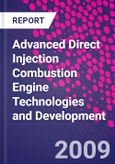Direct injection enables precise control of the fuel/air mixture so that engines can be tuned for improved power and fuel economy, but ongoing research challenges remain in improving the technology for commercial applications. As fuel prices escalate DI engines are expected to gain in popularity for automotive applications. This important book, in two volumes, reviews the science and technology of different types of DI combustion engines and their fuels.Volume 1 deals with direct injection gasoline and CNG engines, including history and essential principles, approaches to improved fuel economy, design, optimisation, optical techniques and their applications.Volume 2 investigates diesel DI combustion engines, which despite their commercial success are facing ever more stringent emission legislation worldwide. Direct injection diesel engines are generally more efficient and cleaner than indirect injection engines and as fuel prices continue to rise DI engines are expected to gain in popularity for automotive applications. Two exclusive sections examine light-duty and heavy-duty diesel engines. Fuel injection systems and after treatment systems for DI diesel engines are discussed. The final section addresses exhaust emission control strategies, including combustion diagnostics and modelling, drawing on reputable diesel combustion system research and development.
Automotive Injector Nozzle Market - Global Industry Size, Share, Trends Opportunity, and Forecast, 2020-2030F
- Report
- 183 Pages
- Global








